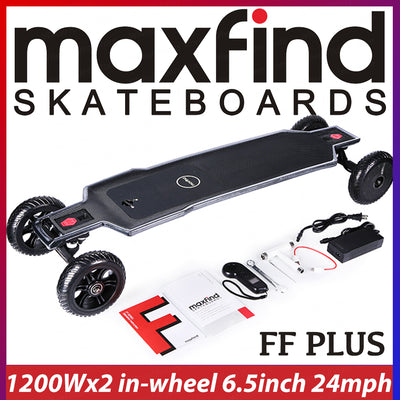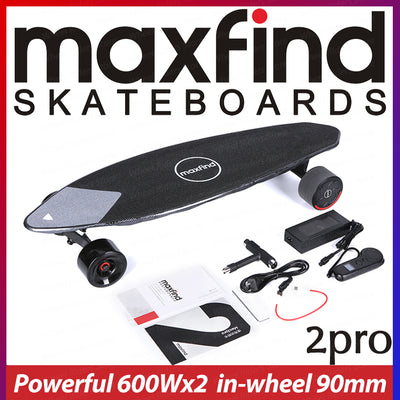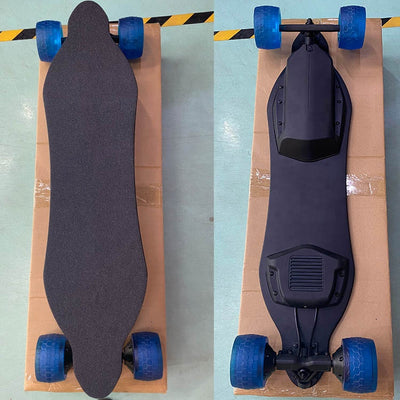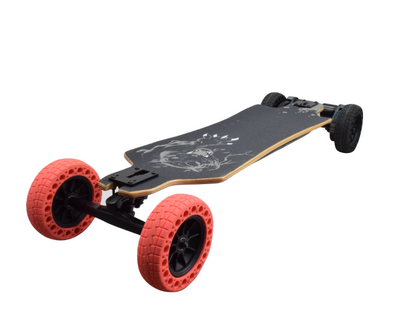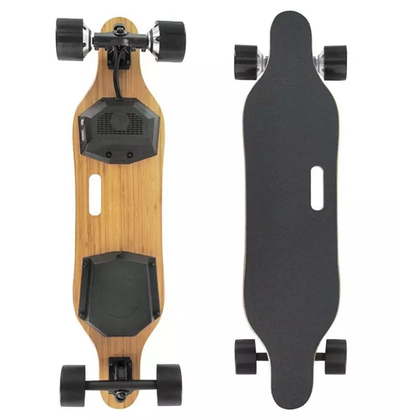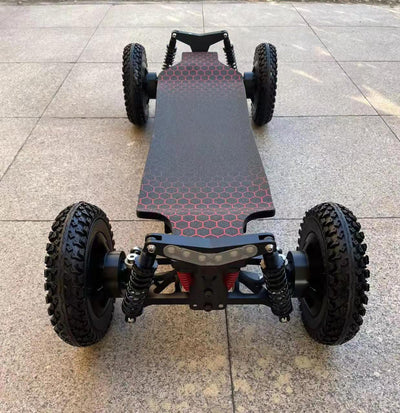Expert Buying Advice for Choosing an Electric Skateboard
Posted by Tom Lee on
How do you pick out the perfect electric skateboard? Curious what one even is? Feeling lost when looking at hub motors versus belt driven, or trying to compare different lithium batteries or motor sizes? We bought the best models on the market, put them through a rigorous series of tests, and learned quite a bit about these products on the whole throughout the course of our testing. We then compiled this step-by-step guide to help you decide on the perfect model for you and why. Keep reading to find out more, or if you want more product specific information, and want to see which brands came out on top, take a peek at our comprehensive review with comparative side-by-side testing to see which model we crowned the Best Electric Skateboard.
Why Buy One?

After seeing one of these zooming by you or zipping up a hill, it won't take a lot of convincing for you to want one. For the experienced boarder, these products allow you to ride a skateboard without the inconvenience of pushing, and descending hills no longer seem as scary when you have the safety of a brake. The majority of these products are also great for the novice boarder, or for those looking for an alternative commuter vehicle.
These boards are a great supplement for public transit, as they are small and portable enough to carry on most buses, trains, or cabs, and have the range and speed to comfortably get you where you need to go, essentially solving the Last Mile Problem. While these skateboards can be a hefty investment, many users may be able to effectively let the boards pay for themselves over a year or two, by saving your daily taxi, rideshare, bus, or metro fare. However, you should always make sure that you are aware of, and following all the local laws and regulations where you are intending on riding, as well as wearing all the appropriate protective and safety equipment.
Now that you are stoked on skateboards powered by electricity, it's time to look at the different types available, and figure out which one is the best fit for you.
Step 1: New to Skateboarding? Already a Pro?
Intrigued by the idea of an electric board? Looking to get into skateboarding now that it doesn't require much work to get up those hills? You might be considering if this is a good tool for quick trips around town, or are just looking for something fun. Initially, you may want to consider one of the more budget options, typically a standard, single wheel drive. These models are less expensive and less intimidating for a new user, especially if you are unsure how often you will be riding, and if you are actually going to enjoy it. At the very least, you should make sure that there are dedicated beginner or learning modes available to minimize the risk of injury.
For the advanced boarder looking to take their ride to the next level, you should consider one of the more performance models. This could be one of the dual-wheel drive models or one of the off-road models. These have a much higher overall speed, and in some cases, have enough acceleration to actually throw you off the board. While these boards aren't exclusively for advanced users, it really does take a decent amount of skill to use these products to their full potential, and it may be wasteful for many people to pay for performance that it is unlikely they will use.
In addition, getting a model that scored solidly in our brake tests is probably a good idea for a new rider…and for an experienced one. It adds a certain level of security that you may be lacking as a beginner. However, all of the models we tested use an electronic brake, rather than a mechanical one — meaning that it can be disabled if the board malfunctions. You need to consult the manufacturer's instructions regarding the brake, and always have a plan if the brakes fail.
Step 2: Where are you Going to Ride?
Now that you know what type of board you want, it's time to look at where you will be riding. Any of these boards will do fine on smooth, flat pavement, but it is a different story when it comes to steep hills or rough roads. Only a handful of boards can make it up the steeper hills, as shown by our hill climbing tests, definitely making this a consideration if you are planning on riding in an area with large hills.

However, this may mean that you are restricted to one of the performance boards, which can be a little intimidating to a beginner. In this case, it may be worthwhile considering if you really want to be skateboarding on steep hills as a beginner.
Those in areas with rougher roads or are planning on riding off-road should consider — unsurprisingly — an off-road model. If the pavement around you is only moderately or intermittently bad, you can probably get away with the larger and softer sizes of standard longboard wheels, something 80 mm or over in diameter, and about a durometer of 76A or softer would be a good baseline.
Those with consistently terrible pavement, or are planning to ride on packed dirt or sand really need to consider a model that has pneumatic tires. These models have better traction and can either be a performance model with dual wheel drive, or a large tire monowheel board.
Step 3: Planning on Commuting? Traveling? Riding for Fun? Living in a Wet Locale?
Hopefully, at this point, you have narrowed your selection down to a specific type of board, and you are just looking at a handful of models. Here is where your exact use can make a big difference on which model is the best board for you. A commuter will want to ensure that their board has sufficient range to get them to and from the office, or that it will at least make it to the workplace and will recharge enough during the day in time to get you home.
In addition to Range, you will also want to think about the weather you will be riding in. Water and electricity aren't usually a good combo, so it's important to consider how wet your daily commute tends to be. Many manufacturers — and common sense — dictate that you should not ride in the middle of a pouring rainstorm, but getting a board that is water resistant can make the difference between puddles left after the storm being a mild inconvenience or an insurmountable obstacle. You should always check, and comply with, the manufacturer's recommendations when it comes to water with your board
If you are planning on flying with your board, then it is important that your board complies with the TSA Lithium Battery Regulations. Some of the models available have batteries that are too large to be carried on a plane without prior permission, or even at all, making these a bad choice if you want to be a frequent flyer with an electric skateboard. In addition, it is important to check that you will be in compliance with the local rules and laws regarding powered or electric skateboards, as it will be quite difficult for these boards to pay for themselves if you keep getting fat tickets every time you ride it!
Step 4: Are You Buying a Board, or Investing in a Company? I'm Looking at You, Kickstarter.
Finally, you are all set. You have picked out which type of board is the best for you, and are ready to buy it. You then realize that you can't buy your board right now, but that you can pledge money on Kickstarter.com and receive your skateboard as a reward at a later date. A key thing to realize is that you are investing in this project, for a reward, rather than directly buying a product. In essence, there isn't much you can do if a Kickstarter fails. Kickstarter even states in their FAQ's:
While there are some benefits to getting a board this way — such as getting the latest and greatest tech, and the satisfaction of helping a budding company take off — in our experience, we would NOT recommend doing this. After pledging in multiple electric skateboard Kickstarters, we found that many of them were incredibly behind schedule. In addition, we found that these products are prone to breakage and having an attentive customer service department is incredibly important. Many of these budding companies don't quite have an established infrastructure yet and can make getting a board repaired or replaced a complete headache. Based on our experience over the past 2 years, we would highly recommend against a Kickstarter board. We have failed to receive 2 boards, and some customer service exchanges have been incredibly frustrating. This was just our experience, and ultimately it is up to you to decide if you are willing to gamble your hard-earned money on a Kickstarter campaign, but we would caution against this, and instead recommend you wait until the board is available at an established retailer, or select a different model entirely.
Types of Electric Skateboards
Now that you know what aspects of the board are best suited for you, and where you might want to buy one, it's time to examine the different types out there to further narrow down your choice.
Standard Single
This style of board is usually more of a budget option, keeping costs low by only having one wheel powered. These boards typically have a lower top speed, less acceleration, and can't handle the steeper hills. These boards can also be a little less controlled when braking, as only one wheel is being slowed down and can cause you to turn or slide slightly.
Standard Double
The top of the line when it comes to electric skateboards, these boards have a pair of motors mounted off of the back trucks. Driving each back wheel increases your traction, stability, and usually are much more powerful than single wheel drive systems. These motor are paired to the wheels with either toothed belts or gears, and sometimes allow different options for maximizing top speed, or peak acceleration. These boards can be fast, almost too fast for beginners, but usually have a beginner mode with a limited speed and acceleration, to help get a feel for the board safely.
Hub Motor
Initially, you may be surprised to see that these boards are powered, as there is no visible motor. Instead, these boards build the motor inside the wheel, aptly naming it a hub motor. While these boards offer a much sleeker, more compact, and minimalistic design, these do have some drawbacks. This style of motor can drive up the cost of the board, and make replacing a wheel much more difficult, restricting you to purchasing a replacement directly from the manufacturer. In addition, these models can also be underpowered when compared to the models that use a reduction drive train.
Off-Road
For those that live in an area where the pavement isn't the best, or are planning on riding on packed dirt, an off-road model is a must. The best boards will have a larger, pneumatic tire with a knobby tread, with sufficient power to effectively drive these monster wheels. These boards can handle some surprising terrain features, much more than you might expect.

The downside is that these boards can be much more expensive, either with a higher base price or necessitates the purchase of an upgrade kit.
Monowheel
These boards, noticeably, rely on a single wheel in the center of the board and rely on internal sensors — gyroscopes and accelerometers — to balance and keep you on the board. Acceleration and braking are determined by the amount you are leaning on the long axis of the boards, and steering is accomplished by rolling on the short axis of the board with your heels and toes. Consequently, these boards can have a little higher learning curve than other models. However, these model are exceptionally fun and can do great at off-road terrain.
Due to the sophisticated nature of these monowheel boards, and their performance being so closely tied to their internal programming and sensors, it pays to get the best. We tested a discount version of one of these boards, and it was a solid disappointment, almost impossible to ride for most people. It's definitely worth it to spend a little extra money for the best when it comes to a single wheel board.
Anatomy of an Electric Skateboard
Rolling onto the scene in the past few years, electric skateboards have since blossomed into the mainstream, with multiple manufacturers releasing various models. As these are a relatively new item, we have put together this section to help you understand the various parts of a board, and what they do. This section is a little technical, aimed at those that want to get into all the technical aspects of how these boards actually go, or if you are digging
Remote
All of these products have a wireless, handheld remote that is used to control the throttle and brakes of the board. Some also have helpful indicators showing remaining battery life, and what mode the board is in. These also should all be set up in a way that the board will stop immediately if you fall off, usually through a dead man's switch. You can also activate the brake, allowing you to stop easily.
Battery Pack
The advent of powerful lithium batteries really helped drive these products to productions, and almost every model of board out there will use a lithium battery pack. While these light, high-powered batteries are the cornerstone of most modern electric vehicles and tech gadgets, they can be hazardous if used incorrectly. You should always closely follow the manufacturer's instructions on charging and use, and never substitute third-party chargers to minimize risk. There also are limits on shipping and flying with these batteries, so you should always make sure you are aware of and complying with regulations before shipping or transporting your board anywhere.
Electronic Speed Controller/On-Board Computer
The internal brains of the board, the speed controller and computer will communicate with the handheld remote, commanding the motors at the appropriate speed at killing power if the signal is lost between the board and the remote. It will also monitor the battery to make sure it is being safely charged and discharged, and alert you when the battery is low.
The short answer is: Don't. These are pretty technical terms related to the commutation, or control of a brushless motor, and won't noticeably affect the performance of the board. The difference is essentially having a louder, slightly faster board compared to a more efficient board with greater pickup, and the effects are so small it shouldn't really impact your purchase decision.
Motor
Complementing the advent of lithium batteries, high-powered, miniature brushless motors have been a cornerstone of making small electric vehicles readily available to the consumer. We would recommend you only look for a board that has a brushless motor system, whether it is a hub motor built into the wheel or mounted off the truck and uses a drive belt. Brushed motors are typically too heavy and underpowered for this application, and will probably disappoint.
Conclusion
Hopefully, this guide has helped you make it clear exactly which type of electric skateboard would be the best for you, and why you would even want one. For more help in picking a specific model,check out our comprehensive electric skateboard review to see which models came out on top overall, and which ones excelled in certain areas. Just remember to always comply with local laws and rules, and to always wear proper protective equipment when riding around in style on your new board.
- Tags: Electric Skateboard











